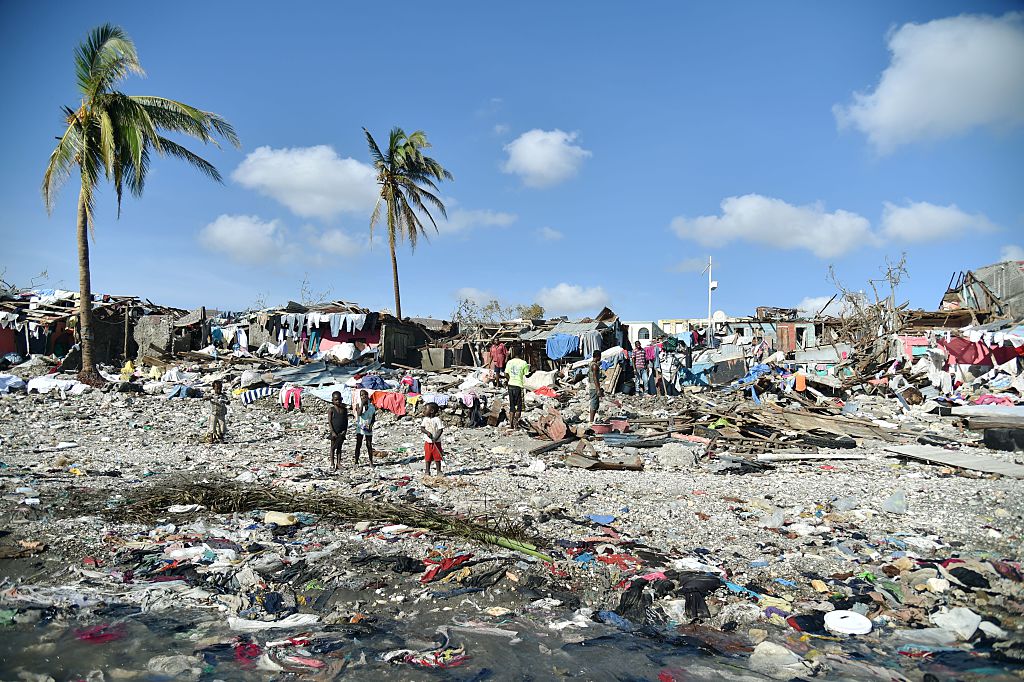JEREMIE, Haiti -- At least 470 people have died in one district of Haiti’s hard-hit southwest region as authorities slowly reach marooned areas devastated by Hurricane Matthew, a civil defense official said Saturday.
Haitian authorities have struggled to reach many of the hardest-hit areas, however, likely keeping the official death toll low. Various news agencies have reported the toll at closer to 900, based on accounts from health workers and rescuers on the ground in Haiti.
And even with the storm hundreds of miles away, grinding slowly up the coast of South Carolina, Matthew continues to claim new lives in Haiti by leaving a fetid stew of floodwater and debris in its wake in a country with a weak infrastructure that was already dealing with a deadly cholera outbreak.
The Reuters news agency said Haitian officials had reported at least 13 deaths from the disease in the hurricane’s wake, and there were fears that number could rise rapidly.
Reuters quoted Donald Francois, head of the Haitian health ministry’s cholera program, as saying 62 people were sick with cholera as a result of the storm.
Fridnel Kedler, coordinator for the Civil Protection Agency in Grand-Anse, told The Associated Press that officials still have not been able to reach two communities in that department three days after the Category 4 storm hit.
“The death toll is sure to go up,” he said.
Officials are especially concerned about Grand-Anse, located on the northern tip of the southwest peninsula, where they believe the death toll and damage is highest. When Category 4 Hurricane Flora hit Haiti in 1963, it killed as many as 8,000 people.
Haiti’s overall death toll remains unknown. Death counts are frequently difficult to tabulate in the immediate aftermath of a natural disaster in any country, though it is particularly difficult in remote and mountainous southwest Haiti.
The Pan American Health Organization and others warned of a surge in cholera cases because of the widespread flooding caused by Matthew. Haiti’s cholera outbreak has killed roughly 10,000 people and sickened more than 800,000 since 2010, when it was introduced into the country’s biggest river from a U.N. base where Nepalese peacekeepers were deployed.
Sophia Cheresal, deputy medical coordinator of Doctors Without Borders in Haiti, said there were at least 18 cases of cholera at the Jeremie hospital alone. “It’s getting worse and probably some people are going to die.”
U.N. emergency relief coordinator Stephen O’Brien called the hurricane’s damage a major blow to Haiti’s reconstruction effort and the fight against cholera.
“We expect that homes, schools and cholera treatment facilities have been destroyed and that water systems, roads and bridges have been severely damaged,” he said in a statement that also announced that the U.N.’s Central Emergency Response Fund was releasing $5 million to help Haiti. Earlier this week, the fund released a loan of $8 million to UNICEF to scale up response to Haiti’s cholera epidemic.
In Jeremie, the main city of Grand-Anse, Jislene Jean-Baptiste surveyed what remained of the one-room house that the grandmother shares with her three daughters and their children. There wasn’t much left. Storm surge flowed across the road and drenched everything she owns in waist-deep salt water, washing away the stores of rice and sugar she regularly sold at the market to support her family. Then the wind tore off her roof.
“That storm was the most terrifying thing that ever happened here,” she said.
Many of her neighbors are in a similarly dire situation because of the storm that has killed hundreds of people in Haiti. Its government has estimated at least 350,000 people need some kind of assistance in what is likely to be the country’s worst humanitarian crisis since a devastating earthquake in January 2010.
Katrina Legner, a 23-year-old mother of two, also saw the storm destroy her small, concrete-block home before she fled to a cousin’s house of a cousin that was also wrecked. “We have very little food and I’m getting worried,” she said.
Amid the suffering, aid began pouring into the coastal town of Jeremie, where thousands of homes were damaged or destroyed and many people were running low on food and facing an increased risk for cholera. Dozens of young Haitians came to the small airstrip along the coast to watch as a helicopter was unloaded with crates of food and water.
“My home is totally wrecked and I heard they were bringing food,” said Richard David, 22, one of those who came to the airport. “I haven’t had anything but water today and I’m hungry.”
Saint-Victor Jeune, an official with the Civil Protection agency working in Beaumont, in the mountains on Jeremie’s outskirts, said 82 bodies found by his team had not been recorded by authorities in the capital because of spotty communications. Most appeared to have died from falling debris from the winds that tore through the area at 145 mph on Tuesday.
“We don’t have any contact with Port-au-Prince yet and there are places we still haven’t reached,” Jeune said, as he and a team of Civil Protection agents in orange vests combed the area.
The storm left signs of devastation all around the southwestern peninsula. Outside Jeremie, home after home was in ruins. Drew Garrison, a Haiti-based missionary who flew in Friday, said several fishing villages were submerged and he could see bodies floating in the water.
“Anything that wasn’t concrete was flattened,” said Garrison, whose organization, Mission of Hope Haiti, based in Austin, Texas, was bringing in a barge loaded with emergency supplies on Saturday. “There were several little fishing villages that just looked desolate, no life.”
Solette Phelicin, a mother of five who lost her home and her small fruit and vegetable plot, watched from her yard as U.N. peacekeepers patrolled the airstrip. She said they were hungry and desperately in need of food.
“Jeremie might get rebuilt after I’m dead, maybe, but I doubt it,” she said.
As Haitians mourned their losses, they tried to recover what they could of their belongings. Homes throughout the area were piles of rubble, the roofs mangled or stripped away.
Those killed in Haiti by Matthew included a woman and her 6-year-old daughter who frantically abandoned their flimsy home and headed to a nearby church to seek shelter as Matthew surged in early Tuesday, said Ernst Ais, mayor of the town of Cavaillon.
“On the way to the church, the wind took them,” Ais said.
© 2016 CBS Interactive Inc. All Rights Reserved. This material may not be published, broadcast, rewritten, or redistributed. The Associated Press contributed to this report.


